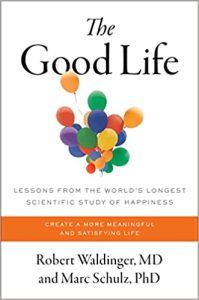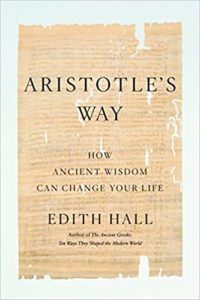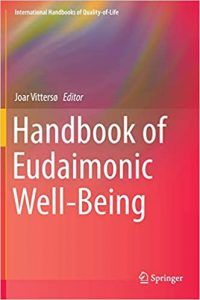Hedonic vs. Eudaimonic Wellbeing: How to Reach Happiness

As you are now, young or old, would you say you enjoyed a life well lived?
That begs the question: What is a life well lived?
You are not alone when grappling with this question. There has been a dramatic rise in research on what constitutes a “good life” and how we can achieve it.
Many researchers have returned to the wisdom of the ancient Greeks to illuminate the nature and core ingredients of a good life.
More specifically, they analyzed the distinction between eudaimonic versus hedonistic wellbeing. The philosopher Aristotle (2009) explored eudemonia in the 4th century BCE in his Nicomachean Ethics. Yet many other philosophers, too, as well as a growing cohort of modern happiness researchers, have engaged with the question of what is worth pursuing in life — and why.
Let’s explore their research and see their verdict on how to reach happiness.
Before you continue, we thought you might like to download our three Happiness & Subjective Wellbeing Exercises for free. These detailed, science-based exercises will help you or your clients identify sources of authentic happiness and strategies to boost wellbeing.
This Article Contains:
- What Are Eudaimonic & Hedonic Wellbeing?
- 10 Real-Life (and a Few Fictional) Examples
- Psychology Theories Behind the Concepts
- A Look at Eudaimonic Motivation
- How to Reach Eudaimonic Happiness
- 3 Activities for Your Coaching Sessions
- 2 Scales & Questionnaires to Measure Wellbeing
- Most Fascinating Books on the Topic
- A Take-Home Message
- References
What Are Eudaimonic & Hedonic Wellbeing?
There is no universal agreement on the precise meanings of the terms eudaimonic and hedonic wellbeing. We can broadly define eudaimonic wellbeing as a function or orientation toward “growth, authenticity, meaning and excellence” (Huta & Waterman 2014, p. 1448).
Hedonism comes from the Greek word hedone, which means pleasure (Harper, n.d.a). Hedonic wellbeing, by contrast, is usually discussed in terms of experiences, a focus on desire fulfillment and pleasure seeking, and the presence of positive affects and the absence of negative ones.
In other words, hedonic happiness is about maximizing pleasure and minimizing displeasure. It is a subjective form of wellbeing, measured by cognitive evaluations of life satisfaction and by the predominance of negative or positive affect. It also tends to be associated with sensual desire fulfillment, although it can take other forms, too.
The debate about eudaimonic vs. hedonic wellbeing usually contrasts self-fulfillment with maximizing pleasure; value- and virtue-oriented living with prioritizing enjoyable experiences; and designing for long-term flourishing vs. seeking short-term gratification. But the matter is more complex than that.
| Eudaimonic | Hedonic |
|---|---|
| Self-fulfillment | Maximizing pleasure |
| Virtue-orientated living | Prioritize enjoyable experiences |
| Long-term flourishing | Short-term gratification |
The Greek word eudemonia combines the words eu, meaning good, and daemon, meaning lesser god, guiding spirit, or tutelary deity (Harper, n.d.b). It has also been translated as “true self.” We can think of eudemonia as the condition of being in “good spirits” or striving toward a divine state of being.
Eudemonia has been translated as happiness, wellbeing, welfare, thriving, fulfillment, or flourishing (Deci & Ryan, 2008; Huta & Waterman, 2014; Heintzelman, 2018). In the popular imagination, eudemonia is also firmly linked to the notion of the “good life.”
Aristotle considered eudemonia as humanity’s highest good.
Crucially, Aristotle did not think of eudemonia as a modality of happiness as we understand it today — a fleeting state of joyous arousal or a subjective, pleasurable state of wellbeing.
Instead, Aristotle (2009) firmly connected eudemonia with the concept of virtuous living. The eudaimonic life is one of virtuous activity, exercised in accordance with reason. It is also oriented toward excellence.
Aristotelian eudemonia, then, is not a passive state, but consistent activity that reflects virtue and excellence, strives to exhibit the best within us and to develop our potentials, and involves the exercise of reason.
The scholar Edith Hall (2018) defines eudemonia as a state of mind we can achieve by practicing virtue ethics. Huta and Waterman (2014, p. 1426) propose that eudemonia reflects the “pursuit of virtue, excellence, and the best within us.”
Waterman (2011) also emphasizes the importance of fulfillment in his studies on eudemonia. He holds that self-realization and the identification and development of our best potentials are the most significant element of eudemonia.
In the Stanford Encyclopedia of Philosophy, Hursthouse and Pettigrove (2022, para. 23) define eudemonia as a “moralized or value-laden concept of happiness, something like ‘true’ or ‘real’ happiness or ‘the sort of happiness worth seeking or having.’” They also rightly point out that it is a concept about which there can be considerable disagreement, for most people have very different views on what constitutes the “good life.”
The Greek philosopher Epicurus also cared a great deal about happiness. Yet his views differed greatly from Aristotle’s. He believed that the good life is by definition oriented toward hedonism, maximizing pleasurable experiences and minimizing pain and discomfort (Wilson, 2015).
Epicurus firmly held that pleasure is the only intrinsically good thing and that pain is the only intrinsically bad thing on earth. In Epicurus’s books, a good life is one that is filled with as much pleasure, delight, and ecstasy as possible and relatively free from pain or distress (Wilson, 2015).
Henderson et al. (2013, as cited in Jenkins et al. 2022, p. 2) have shown that hedonic wellbeing “is associated with increased positive affect, vitality, and life satisfaction, and that hedonic-oriented (i.e., pleasure-seeking) behaviors are associated with reductions in negative affect, depression, and stress.”
10 Real-Life (and a Few Fictional) Examples

They seek to avoid feelings of pain, displeasure, and boredom at all costs. They are present- rather than future-oriented. In Freudian terms, we could say they are firmly wedded to the pleasure principle.
Their more Aristotelian counterparts, by contrast, practice virtues such as temperance, patience, moderation, and self-control. They privilege doing good over feeling good. They strive for excellence and fulfillment and also aspire to non-egoic motivations. They show perseverance and can renounce short-term pleasures for future gains.
We can find an example of these two opposites in Greek antiquity. More specifically, in their pantheon of gods. Many philosophers, too, especially the German philosopher Friedrich Nietzsche (1872/1993), have referred to two sons of Zeus in particular as shorthand for opposing qualities and ways of life.
In Greek mythology, Apollo, the sun god, is associated with reason, order, logic, and prudence. He is also the god of music, which requires an effortful and persistent acquisition of skills, and healing (Nietzsche, 1872/1993).
His counterpart, Dionysus, by contrast, is the god of wine and dance. Dionysus represents irrationality and chaos, as well as passion, emotion, and instinct. In many stories, Dionysus is associated with intoxication, wild parties, and sexual orgies.
Regarding hedonists in history, King Henry VIII is well known for his excessive love of red meat and women. Casanova and Don Juan are two figures who privileged womanizing above anything else in their lives.
The poet Oscar Wilde, too, was known for his love of pleasure. So were Ava Gardner and Frank Sinatra. Think also of the writer F. Scott Fitzgerald’s (1925/2000) famous novel The Great Gatsby, in which he describes the hedonic excesses of the hard-drinking and perma-partying revelers in the 1920s Jazz Age.
At the opposite end, on the eudaimonic spectrum, there are numerous saints and monks who renounce most worldly pleasures and live ascetic lives that are geared toward enlightenment and spiritual fulfillment. We can also think of extremely hard-working, disciplined entrepreneurs with long-term visions, such as Steve Jobs.
Psychology Theories Behind the Concepts
Are eudaimonics happier than their hedonic counterparts? What does psychology say?
The great theoretical debate
Many psychologists debate whether eudemonia is a function, orientation, state, set of traits, or set of measurable behaviors. Huta and Waterman (2014) suggest that we can think of eudemonia in terms of an orientation toward personal growth and feelings of engagement (Vittersø, 2013), feelings of meaningfulness (Delle Fave et al., 2009), or as a checklist of specific behaviors (Steger et al., 2008).
We can also assess eudemonia in terms of cognitive-affective experiences (such as positive affect, life satisfaction, enjoyment); positive mental functioning; or orientations toward self-actualization, value-led living, personal growth, and fulfillment.
In hedonism, by contrast, the “focus is placed on happiness as pleasure, enjoyment, and absence of discomfort understood as subjective affective states” (Huta & Waterman, 2014, p. 1427). Hedonism tends to be associated in terms of high positive affect, low negative affect, and overall high life satisfaction.
An interesting alternative definition of eudemonia has been proposed by Keyes (2002), who argues that eudemonia necessarily entails a combination of psychological and social wellbeing. He emphasizes that eudemonia is not just about personal growth and value-led living, but also about relationships and community contribution. In other words, Keyes proposes that there needs to be an altruistic dimension to our lives if we want to live well.
Human flourishing
Seligman (2011) and Peterson et al. (2005) similarly argue that eudemonia should not just entail identifying our unique virtues and developing them. Crucially, we also have to put these strengths to work for the greater good and the welfare of humanity at large.
At the face of it, then, eudaimonics in the Aristotelian vein seem to make more sensible choices for flourishing in the long run than do hedonists. However, it is important to note that lives completely devoid of hedonic pleasures are also not worth living.
Such lives become sterile, frigid, and joyless. Anhedonia is not a condition anyone wishes to aspire to. Schotanus-Dijkstra et al. (2016) found that people who truly flourish have high levels of both eudaimonic and hedonic wellbeing.
Flow
Flow theory is another important concept in this context. First named by Csíkszentmihályi in 1975, flow can be a highly energizing, pleasurable, even ecstatic state, too (Csíkszentmihályi, 1990).
We can experience moments of joy and delight not just from hedonistic sensual pleasures such as sex, drink, and food, but also from skillful activities that require high concentration and that are associated with long-term flourishing.
In positive psychology, a flow state is a mental state in which we are fully immersed in and completely absorbed by what we are doing. We may lose our sense of time, and our sense of self in a state of flow (Nakamura & Csíkszentmihályi, 2001). Delle Fave et al. (2009) identify flow as a core component of eudemonia.
Activities that can lead to flow states are not at all classic hedonic ones. They could include exercising a skill, such as playing an instrument or making something with our hands, writing, martial arts, running, painting, and many other things besides.
Yet the feeling state resulting from these activities can be similar to those we can gain in hedonic activities. Just as we might lose ourselves at the height of a hedonic experience, we may lose ourselves in a state of flow. The difference is that hedonic pleasure usually has no long-term benefits and can even have negative long-term effects on our thriving.
A Look at Eudaimonic Motivation

Interestingly, Bauer et al. (2011) include transcending self-interest and being able to see ourselves as interdependent, as well as perspective taking, complexity thinking, and an understanding of long-term consequences of our actions in their definition.
Huta and Ryan (2010, as cited in Huta & Waterman, 2014, p. 1446), too, define eudemonia primarily as a motive, “striving to use and develop the best in oneself, in ways that are congruent with one’s values and true self.”
Huta and Ryan (2010) also found the following interesting fact in their study that explored the motivation of four different groups.
One group was pursuing hedonic motives only, one eudaimonic, one both, and one none at all. Their core finding was that “individuals with both high hedonic and high eudaimonic motives—as compared to individuals in the other three groups—had the most favorable outcomes on vitality, awe, inspiration, transcendence, positive affect, and meaning” (Schotanus-Dijkstra et al., 2016, p. 1352).
In other words, people flourish most if they pursue both hedonic and eudaimonic motives at the same time.
Jenkins et al. (2022, p. 2) also found that “experiencing and integrating both types of wellbeing contribute to what psychologists have termed ‘flourishing.’”
How to Reach Eudaimonic Happiness
These strategies can help us aspire toward eudaimonic wellbeing:
- Know your values and aspire to live a value-led life.
- Be clear about your long-term goals and aim to take daily steps toward them.
- Reflect on the classical virtues that speak to you and try to put them into action.
- Take good care of your physical and mental health.
- Appreciate privileged connections.
- Don’t just aim to feel good, but aspire to do good. Feeling good will follow.
- Seek flow states.
- Aim for balance in your life. Don’t banish hedonic pleasure from your life completely.
3 Activities for Your Coaching Sessions

It is therefore important to explore the subjective meanings and the feeling states and experiences associated with them in detail.
1. Question – the meaning of fulfillment
Ask your clients what fulfillment and living a good life mean to them. Be curious about the answers and go deeper. Ask them why what they tell you is important to them. What is significant about these activities or states? How are they connected to their deeper values?
2. Question – feeling fully alive
Ask your clients when they last felt fully alive. Invite them to close their eyes and revisit that moment. Where were they? Who was with them? What did they see, feel, hear, smell?
What exactly were they doing? Let them experience this moment in sensually rich detail. When they open their eyes again, analyze the scene together. What was important about that moment?
What can they learn from this experience? Which core ingredients for flourishing can be taken from that scene?
3. Question – real fun
Ask your clients when they last experienced real fun in their lives. When was the last time they laughed so hard they had tears in their eyes? How can they introduce more of what makes them joyful and exhilarated into their lives?
2 Scales & Questionnaires to Measure Wellbeing
To reach happiness requires first understanding where you are now, and that can be done by measuring eudaimonic versus hedonic wellbeing.
In general, measures designed to assess eudaimonic versus hedonic wellbeing tend to focus on orientations, values, motives, goals, behavior characteristics, cognitive-affective experiences, and ways of functioning.
Huta and Waterman (2014) provide a great overview of different kinds of scales and their foci. Proctor and Tweed (2016) provided another useful overview of ways we can measure eudaimonic wellbeing.
Ryff’s (1989) Scales of Psychological Well-Being, for example, assesses eudemonia in terms of traits and qualities associated with positive psychological functioning. Her scale focuses on six characteristics in particular:
- Self-acceptance
- Positive relations with others
- Personal growth
- Purpose in life
- Environmental mastery
- Autonomy
Waterman et al. (2010) developed the Questionnaire for Eudaimonic Well-Being. It assesses eudaimonic functioning at the trait level, with an emphasis on positive functioning. It focuses on:
- Self-discovery
- Perceived development of one’s best potentials
- A sense of purpose and meaning in life
- Investment of significant effort in the pursuit of excellence
- Intense involvement in activities
- Enjoyment of activities as personally expressive
You can find the questionnaire in Waterman et al.’s (2010) paper here.
Most Fascinating Books on the Topic
There are great books on the topic that offer rich inspiration for those who want to explore hedonic and eudaimonic wellbeing more deeply.
Below you will find a selection of three, ranging from self-help to more academic sources.
1. The Good Life: Lessons from the World’s Longest Scientific Study of Happiness – Robert Waldinger and Marc Schulz
This excellent book draws on the insights of the Harvard Study of Adult Development, the longest scientific study of happiness ever conducted. It seeks to answer the question of what makes life fulfilling and meaningful. The simple answer is: connections and the quality of our relationships.
The stronger our relationships, the more likely we are to live fulfilling lives. In fact, the Harvard Study powerfully demonstrates that as we go through life, the strength of our connections with others can predict not just our physical and mental health, but also success in our professions.
Find the book on Amazon.
2. Aristotle’s Way: How Ancient Wisdom Can Change Your Life – Edith Hall
Beautifully written, this book presents elegant and very readable summaries and analyses of Aristotle’s key ideas. It focuses on how we may integrate these insights into our own lives so that we can live in a eudemonia-oriented way.
Hall presents the essence of Aristotle’s timeless teachings in 10 precise and applicable lessons and excels in highlighting the ways Aristotle’s thought is still relevant to us today.
Find the book on Amazon.
3. Handbook of Eudaimonic Well-Being – Joar Vittersø
This academic handbook contains several essays on the theory and empirical findings from eudemonia researchers, covering both historical and philosophical perspectives. It offers a comprehensive account of academic debates of eudaimonic wellbeing.
It includes research on how to live happy lives and what constitutes good societies. It also explores many of the conceptual controversies related to eudaimonic wellbeing. The themes that are explored in this book include emotions, health, wisdom, self-determination, motivation, growth, work, leisure, and heroism.
Find the book on Amazon.
A Take-Home Message
Several researchers have argued that the pursuit of both hedonia and eudemonia produces greater wellbeing than either pursuit alone (Huta & Ryan, 2010). Happiness, in other words, is a multidimensional construct.
So, while we may be inclined to privilege eudaimonic wellbeing over hedonic wellbeing, we should not dismiss the latter completely.
The 80–20 rule may be a good rule of thumb for long-term flourishing, providing a good balance for integrating both eudaimonic and hedonic strategies for wellbeing into our lives.
We hope you enjoyed reading this article. Don’t forget to download our three Happiness Exercises for free.
- Aristotle. (2009). The Nichomachean ethics (L. Brown, Ed., D. Ross Trans.). Oxford University Press.
- Bauer, J. J., Schwab, J. R., & McAdams, D. P. (2011). Self-actualizing: Where ego development finally feels good? The Humanistic Psychologist, 39, 121–136.
- Csíkszentmihályi, M (1990). Flow: The psychology of optimal experience. Harper and Row.
- Deci, E. L., & Ryan, R. M. (2008). Hedonia, eudaimonia, and well-being: An introduction. Journal of Happiness Studies, 9(1), 1–11.
- Delle Fave, A. (2009). Optimal experience and meaning: Which relationship? Psychological Topics, Special Issue on Positive Psychology, 18, 285–302.
- Fitzgerald, F. S. (2000). The great Gatsby. Penguin. (Original work published 1925)
- Hall, E. (2018). Aristotle’s way: How ancient wisdom can change your life. Penguin.
- Harper, D. R. (n.d.a). Hedonism. In Online etymology dictionary. Retrieved March 2, 2023, from https://www.etymonline.com/search?q=hedonism.
- Harper, D. R. (n.d.b). Daimon. In Online etymology dictionary. Retrieved March 2, 2023, from https://www.etymonline.com/search?q=daimon.
- Heintzelman, S. J. (2018). Eudaimonia in the contemporary science of subjective well-being: Psychological well-being, self-determination, and meaning in life. In E. Diener, E. Oishi, S., & Tay, L. (Eds.), Handbook of well-being. DEF.
- Hursthouse, R., & Pettigrove, G. (2022). Virtue ethics. In E. N. Zalta & U. Nodelman (Eds.), The Stanford encyclopedia of philosophy. https://plato.stanford.edu/archives/win2022/entries/ethics-virtue/.
- Huta, V., & Ryan, R. M. (2010). Pursuing pleasure or virtue: The differential and overlapping well-being benefits of hedonic and eudaimonic motives. Journal of Happiness Studies, 11, 735–762.
- Huta, V., & Waterman, A. S. (2014). Eudaimonia and its distinction from hedonia: Developing a classification and terminology for understanding conceptual and operational definitions. Journal of Happiness Studies, 15(6), 1425–1456.
- Jenkins, M., Lee, C., Houge Mackenzie, S., Hargreaves, E. A., Hodge, K., & Calverley, J. (2022). Nature-based physical activity and hedonic and eudaimonic wellbeing: The mediating roles of motivational quality and nature relatedness. Frontiers in Psychology, 13.
- Keyes, C. L. M. (2002). The mental health continuum: From languishing to flourishing in life. Journal of Health and Social Behavior, 43, 207–222.
- Nakamura, J., & Csíkszentmihályi, M. (2001). Flow theory and research. In C. R. Snyder & S. J. Lopez (Eds.), Handbook of positive psychology (pp. 195–206). Oxford University Press.
- Nietzsche, F. (1993). The birth of tragedy: Out of the spirit of music. Penguin. (Original work published 1872)
- Peterson, C., Park, N., & Seligman, M. E. P. (2005). Orientations to happiness and life satisfaction: The full life versus the empty life. Journal of Happiness Studies, 6, 25–41.
- Proctor, C., & Tweed, R. (2016). Measuring eudaimonic well-being. In J. Vittersø (Ed.) Handbook of eudaimonic well-being. International handbooks of quality-of-life. Springer.
- Ryff, C. D. (1989). Happiness is everything, or is it? Explorations on the meaning of psychological wellbeing. Journal of Personality and Social Psychology, 57, 1069–1081.
- Schotanus-Dijkstra, M., Pieterse, M. E., Drossaert, C. H., Westerhof, G. J., De Graaf, R., Ten Have, M., Walburg, A., & Bohlmeijer, E. T. (2016). What factors are associated with flourishing? Results from a large representative national sample. Journal of Happiness Studies, 17(4), 1351–1370.
- Seligman, M. E. P. (2011). Flourish: A visionary new understanding of happiness and well-being. Free Press.
- Steger, M. F., Kashdan, T. B., & Oishi, S. (2008). Being good by doing good: Daily eudaimonic activity and well-being. Journal of Research in Personality, 42, 22–42.
- Vittersø, J. (2013). Feelings, meanings, and optimal functioning: Some distinctions between hedonic and eudaimonic well-being. In A. S. Waterman (Ed.), The best within us: Positive psychology perspectives on eudaimonia (pp. 39–55). APA Books.
- Waterman, A. S. (2011). Eudaimonic identity theory: Identity as self-discovery. In S. J. Schwartz, K. Luyckx, & V. L. Vignoles (Eds.), Handbook of identity theory and research (vol. 1–2). Springer.
- Waterman, A. S., Schwartz, S. J., Zamboanga, B. L., Ravert, R. D., Williams, M. K., Agocha, V. B., Kim, S.Y., & Donnellan, M. B. (2010). The Questionnaire for Eudaimonic Well-Being: Psychometric properties, demographic comparisons, and evidence of validity. The Journal of Positive Psychology, 5(1), 41–61.
- Wilson, C. (2015). Epicureanism: A very short introduction. Oxford University Press.
Let us know your thoughts
Read other articles by their category
- Body & Brain (42)
- Coaching & Application (54)
- Compassion (26)
- Counseling (50)
- Emotional Intelligence (24)
- Gratitude (18)
- Grief & Bereavement (21)
- Happiness & SWB (39)
- Meaning & Values (25)
- Meditation (20)
- Mindfulness (44)
- Motivation & Goals (43)
- Optimism & Mindset (32)
- Positive CBT (25)
- Positive Communication (20)
- Positive Education (44)
- Positive Emotions (30)
- Positive Leadership (13)
- Positive Psychology (32)
- Positive Workplace (33)
- Productivity (16)
- Relationships (41)
- Resilience & Coping (34)
- Self Awareness (20)
- Self Esteem (36)
- Software & Apps (13)
- Strengths & Virtues (30)
- Stress & Burnout Prevention (33)
- Theory & Books (44)
- Therapy Exercises (35)
- Types of Therapy (58)







What our readers think
Great article! Very informative. However, I was disappointed in the “this vs that” emphasis. It is either eudaimonic or hedonistic, although you did mention the combination, I think it could be further explored. In philosophy they use the term Unity of Opposites, in science it is Complementary Pairs. In this case you cannot know happiness unless you know both its eudaemonic and hedonistic aspects. And, you can only study one at a time. But if you only focus on the one, that is all you see. Then you go to the extreme. If you focus only on pleasure, then drugs are the easiest way to get there, until it doesn’t. If you focus on service, then you do that until you suffer compassion fatigue. Nothing wrong, move between the two to find a balance that makes sense. There is nothing wrong with serving others and then taking a meditative walk in the park. After all, “moderation in all things.” Oscar Wilde
Hi Gary,
Thanks for your thoughtful feedback! I appreciate your perspective on the unity and complementarity of eudaimonic and hedonistic aspects in understanding happiness.
I agree, a more nuanced discussion could enrich the narrative. Balance, indeed, is essential in achieving a well-rounded, sustainable happiness.
We’ll take your valuable insights into consideration in future writings.
Kind regards,
Julia | Community Manager
youngsters need this kind of help in exploring their self in a better way.